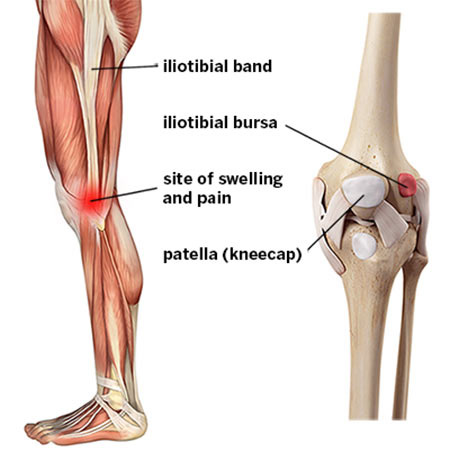 Midtown Manhattan
36 W 44th St Ste 1416 New York, NY 10036
Midtown Manhattan
36 W 44th St Ste 1416 New York, NY 10036
- (212) 621-7746
- text us
- BOOK ONLINE Call for Same Day Appointments
 Midtown Manhattan
36 W 44th St Ste 1416 New York, NY 10036
Midtown Manhattan
36 W 44th St Ste 1416 New York, NY 10036
Iliotibial band syndrome treatment may be in your future if you don’t follow the instructions of your sports medicine team. Stretching and proper warm up before you work out can help you prevent iliotibial band syndrome, a condition that can be very painful and keep you away from most of your physical activities for a long time. If you suffer from Iliotibial Band Syndrome come to our sports injury clinic to get your knee pain evaluation and treatment. Meet our knee doctor Febin Melepura M.D. to get the pain relief you need in the safe, reassuring hands of the best knee specialists in NYC.

If you have a persistent pain on the outside of your knee, there’s a pretty good chance you’re suffering from Iliotibial band syndrome. Athletes are especially prone to this condition. Any activities that cause you to bend your knees repeatedly drastically increases your chances for developing a need for iliotibial band syndrome treatment:
These are just a few in a long list of activities that can lead to problems with your iliotibial bands. Iliotibial band syndrome typically gets better with rest and time. But in some cases, iliotibial band syndrome treatment from your doctor is necessary. A few extreme cases require surgery. Your Midtown Manhattan sports medicine doctor can help you find the best solution for your knee pain.
There’s a thick group of fibers that runs down the outside of your leg from your hip to the top of your shin bone. This is your iliotibial band, or IT band for short. It’s possible for this collection of fibers to get too tight. When this happens, you’re likely going to notice pain and inflammation around your knee.
The fluid-filled sacs around your knee are called bursae. And you have three major bursae in each of your knees. If they’re normal and healthy, they cushion your joints and all of the other moving parts of your knees from friction. This allows your IT bands to slide smoothly as you bend and straighten your knees. If a bursa sac gets inflamed, that’s bursitis.
Pain is going to be your most obvious symptom. You typically experience this pain on the outside of your knee, directly above your joint. This pain can be passing, and you may not take it as seriously as you need to. Over time, the pain often becomes progressively worse. Other symptoms you might have noticed include:
While IT band syndrome isn’t the only source of knee pain, in may be the source of the problem. Your doctor can usually form a diagnosis based purely on your symptoms. A physical exam and simple x-ray can easily eliminate other, potential causes for your condition, such as a sprain or meniscus tear.
Dr. Melepura was really thorough, patient, and helpful with my initial visit. The office staff was were quick to get back to me about my insurance and scheduling a visit as well. The doctor also gave me exercises to do at home to manage the pain on the outside of my knee as well as referrals for PT. Great communication.
Amrutha VinodThere are so many risk factors for this condition, that it’s easier to seek medical advice than it is to lose any sleep over:
There are two important things to remember when faced with pain from your IT band:
Mild stretching and massage are recommended for home iliotibial band syndrome treatment. And over-the-counter anti-inflammatory medications are a go-to way to relieve pain and reduce swelling. If your condition has advanced beyond home remedies, your expert medical provider has other iliotibial band syndrome treatment options such as surgery, knee injections and activity modifications that may include:
Surgery may be required if your case is severe enough. The procedure, known as ITB release surgery, involves cutting a small piece out of your tendon. This is usually removed from where it attaches at the side of your knee.
Skipping your stretching before your workout can lead to pain and swelling in your IT band and bursae. Bending your knee causes friction, and if your IT bands are too tight going into your exercise, the friction can result in more serious damage.
Do you have any questions about the iliotibial band syndrome treatment we offer in NYC? Would you like to schedule an appointment with the best-rated knee doctor Febin Melepura MD of sports pain management clinic in NYC? Please contact our office for consultation with the top pain relief specialist in Midtown Manhattan.
Sports Injury & Pain Management Clinic of New York
Febin Melepura, MD is a top rated, best in class interventional pain management doctor. He is a nationally recognized pain relief specialist and is among the top pain care doctors in New York City and the country. He is an award winning expert and contributor to a prominent media outlets.
Dr. Febin Melepura has been recognized for his thoughtful, thorough, modern approach to treating chronic pain and, among other accolades, has been named a “top pain management doctor in New York”, and one of “America’s Top Doctors™” for an advanced sports injury treatments.